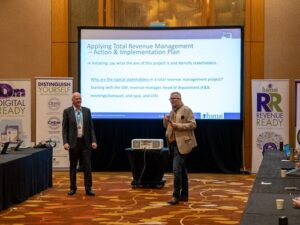 The hospitality industry is on the cusp of a revolution with the advent of Profit-Oriented Revenue Management (PORM). This innovative methodology, spearheaded by Associate Professor Dr Detlev Remy, Senior Lecturer Brandon Chan of the Singapore Institute of Technology, and Anders Johansson, CEO of Demand Calendar, promises to transform how hotels maximize profitability.
The hospitality industry is on the cusp of a revolution with the advent of Profit-Oriented Revenue Management (PORM). This innovative methodology, spearheaded by Associate Professor Dr Detlev Remy, Senior Lecturer Brandon Chan of the Singapore Institute of Technology, and Anders Johansson, CEO of Demand Calendar, promises to transform how hotels maximize profitability.
A Paradigm Shift in Revenue Management
Traditional revenue management in the hospitality sector has long focused on maximizing room revenue. However, introducing PORM emphasises overall profitability and integrates ancillary revenue streams such as food and beverage, spa services, events, and other on-site amenities. This holistic approach ensures a comprehensive strategy to enhance a hotel’s bottom line.
The Evolution of Revenue Management
Revenue management has evolved significantly due to technological advancements, changing consumer behaviour, and dynamic market conditions. Hotels can now utilize dynamic pricing models powered by advanced algorithms and AI to adjust real-time rates based on demand, competition, and market conditions. This departure from static pricing models allows for more responsive and profitable strategies.
Collaborative Strategies for Profit Maximization
PORM encourages collaboration among departments, breaking down silos that traditionally separated revenue management from marketing, sales, and operations. This integrated approach fosters cohesive strategies that enhance overall profitability. Customer engagement is also a cornerstone of PORM, promoting personalized marketing, loyalty programs, and post-stay follow-ups to build long-term relationships and drive repeat business.
Leveraging Data Analytics for Informed Decisions
In today’s competitive landscape, relying on historical booking data and basic metrics like occupancy rates and RevPar is no longer sufficient. PORM leverages data analytics to delve into real-time booking patterns and changing customer behaviours, enabling hotels to respond swiftly to market changes. This data-driven approach ensures more accurate and effective pricing decisions.
Top 10 Actions for Implementing PORM
To effectively implement PORM and boost profitability, hotels can focus on the following actions:
- Understanding Marginal Profit: The commercial team must grasp the marginal profit for every product and service, informing pricing and sales decisions.
- Developing Profitable Products and Services: Focus on high-margin products and services that appeal to the target audience, such as wellness experiences in spa operations.
- Flexible and Creative Packages: Offer packages that combine services, increasing guest spend and improving profit margins.
- Dynamic Pricing Strategies: Implement pricing strategies that adjust based on demand, competition, and market conditions.
- Effective Marketing and Sales: Invest in marketing strategies and training to attract more guests and close sales.
- Optimizing Distribution Channels: Manage distribution channels to promote cost-effectiveness, reducing customer acquisition costs.
- Upselling and Cross-selling: Train staff to upsell and cross-sell, boosting revenue per guest.
- Enhancing Guest Experience: Ensure a positive guest experience to encourage repeat business and positive reviews.
- Investing in Technology: Use RMS, CRM, and PMS to increase efficiency and provide valuable insights.
- Leveraging Data and Analytics: Utilize data-driven insights for informed decision-making and effective strategies.
Implementing PORM: A Three-Step Approach
1. Brainstorm on Implementation
- Identify Stakeholders: Define roles and stakeholders impacted by the shift to PORM.
- Set Clear Objectives: Outline measurable objectives aligned with financial goals.
- Develop a Transition Plan: Create a detailed plan for transitioning to PORM, considering technology adaptation, training, and process changes.
2. Understand the Cost Structure
- Define and Analyze Costs: Break down costs associated with each revenue stream, including Customer Acquisition Costs (CAC) and Cost of Goods Sold (COGS).
- Calculate Customer Acquisition Cost: Determine costs associated with acquiring customers.
- Evaluate Marginal Profits: Analyze marginal profits for each product or service.
- Analyze Profitability: Use cost and profit data to analyze the profitability of each revenue stream and customer segment.
3. Allocate Profit Responsibilities
- Assign Profit Responsibilities: Allocate profit responsibility based on the Profit and Loss (P&L) statement.
- Define KPIs: Establish clear Key Performance Indicators (KPIs) for each stakeholder.
- Encourage Cross-Functional Collaboration: Promote collaboration between operations and commercial teams.
- Monitor and Evaluate: Establish regular checkpoints to evaluate progress and adjust strategies as needed.
Conclusion
The whitepaper on Profit-Oriented Revenue Management calls for hospitality professionals to embrace this revolutionary approach. By adopting PORM, hotels can redefine profitability and equip themselves with the tools and knowledge to thrive in an evolving marketplace. The authors invite industry professionals to share their PORM experiences and engage in collaborative discussions to enhance hotel profitability.
About the Experts:
Dr. Detlev Remy is an Associate Professor at the Singapore Institute of Technology with research interests in revenue management metrics, digital marketing, and data analytics.
Brandon Chan is a Senior Lecturer at the Singapore Institute of Technology with over 30 years of experience in sales, marketing, and hotel management with leading hotel brands.
Anders Johansson is the CEO of Demand Calendar, a pioneer in revenue management since the 1980s, and a strategic revenue management lecturer with over 35 years of hospitality leadership experience.
Access the full whitepaper on Profit-Oriented Revenue Management here for more detailed insights.
Written by: Jason Smith





















